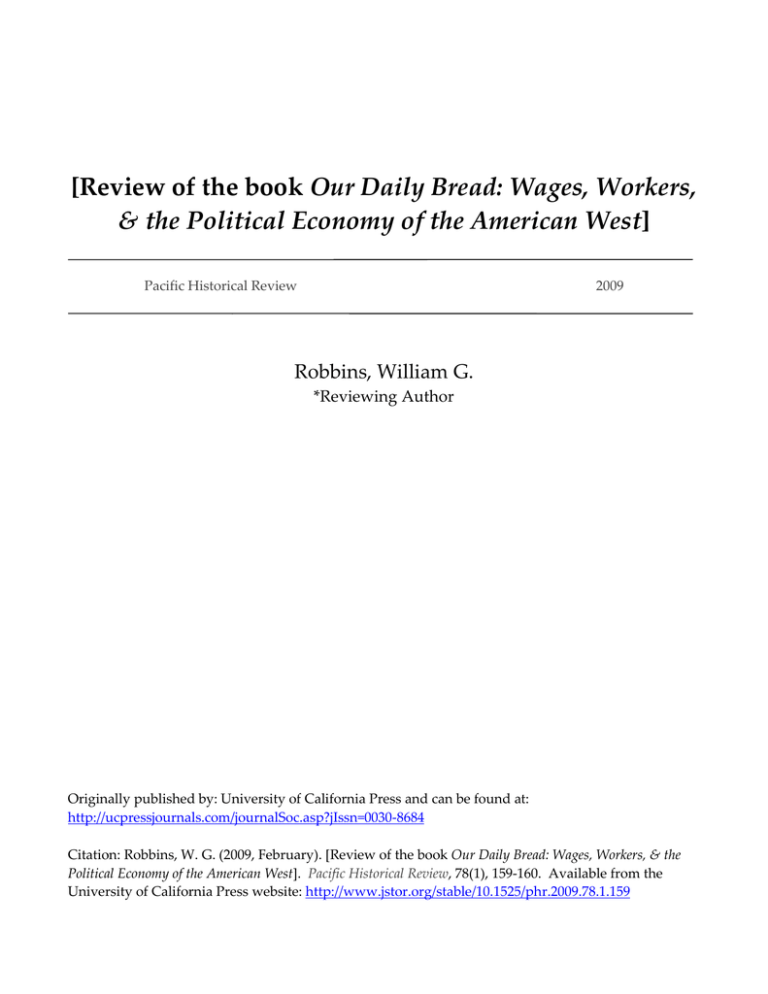Our Daily Bread: Wages, Workers, Robbins, William G.
advertisement

[Review of the book Our Daily Bread: Wages, Workers, & the Political Economy of the American West] Pacific Historical Review 2009 Robbins, William G. *Reviewing Author Originally published by: University of California Press and can be found at: http://ucpressjournals.com/journalSoc.asp?jIssn=0030-8684 Citation: Robbins, W. G. (2009, February). [Review of the book Our Daily Bread: Wages, Workers, & the Political Economy of the American West]. Pacific Historical Review, 78(1), 159-160. Available from the University of California Press website: http://www.jstor.org/stable/10.1525/phr.2009.78.1.159 Reviews of Books 159 Our Daily Bread: Wages, Workers, & the Political Economy of the American West. By Geoff Mann. (Chapel Hill, University of North Carolina Press, 2007. xviii + 245 pp. $59.95 cloth, $19.95 paper) Geoff Mann’s primary interest in this book is the cultural politics of the wage, “what is being determined: what is really at stake in the wage relation” (p. 3). The author argues that the larger context of wage dynamics is hotly contested political terrain, the ground on which laborers struggle with capitalists over the distribution of income, and much more. Historians and labor scholars, he believes, have been obsessed with left-wing labor groups and have ignored the “microradicalisms” of the everyday life of rankand-file workers. Our Daily Bread aims to set the record straight by examining the broader cultural politics of the wage, with special focus on the American West. Readers of this journal will be especially interested in the middle chapters, where Mann turns his attention to three case studies of workers who struggled for equity and a better wage: first, the postwar experiences of Local 128, the Oil Workers International Union, Los Angeles; second, African American lumber workers employed by the Long-Bell Lumber Company in Weed, California; and third, the International Fishermen and Allied Workers of America, representing Pacific coastal fishers. In the first two studies, the wage and race are at the core of the theoretical discussion. For Los Angeles Oil Workers, “the wage was at the center of class struggle” (p. 76), but with “gendered” definitions—males in the work force and women at home—of what properly constituted a family wage. Oil workers did well in the immediate postwar period, winning concessions for shift differentials in pay, gaining “escalator” clauses tied to the cost of living, and striving for guaranteed wages and jobs. Local 128, however, was unable to survive the anti-union politics of the 1950s. For African American workers in Weed during the 1920s, Mann deftly interrogates the cultural politics of race, class, and skill. These workers’ experiences illustrate how owners differentiated the meaning of the wage for white and black laborers: “black workers are unskilled workers, therefore there are black wages” (p. 85). The politics of skill, the author points out, was defined to fit the politics of race. In the case of the coastwide International Fishermen and Allied Workers of America, owners of small boats and their crews insisted that they worked for wages and that they were members of the working class. As “wage earners and primary producers” (p. 138), fishers fought the processors, the federal government, and charges of communism during the Cold War. This PHR7801_05.indd 159 1/5/09 11:39:10 AM 160 Pacific Historical Review truly radical union finally succumbed in the midst of federal indictments and other coercive Cold War tactics. Except for the middle three chapters, Our Daily Bread offers up a very dense theoretical discussion that operates, at best, at the margins of history. If the author’s strategy is to present theory grounded in the material world, then readers should be forewarned that they will need to plow through chapters where the narrative is obtuse, convoluted, and replete with discursive theoretical formulations. Our Daily Bread addresses issues and questions of great potential. Unfortunately, repetition, wordiness, and excessively personalized and confusing prose mar the narrative. Oregon State University PHR7801_05.indd 160 WILLIAM G. ROBBINS 1/5/09 11:39:10 AM





